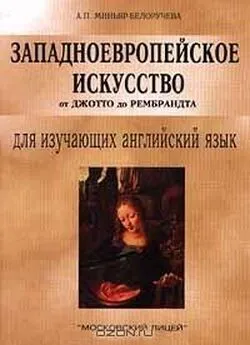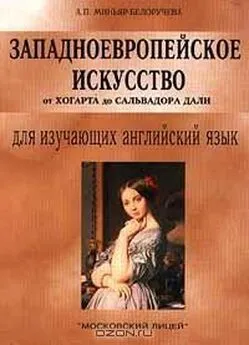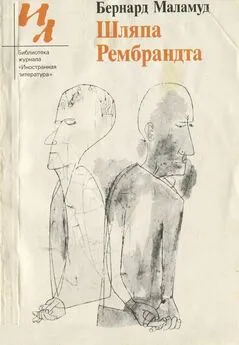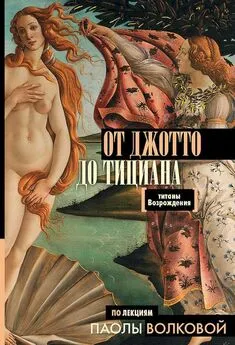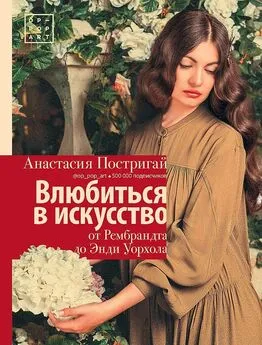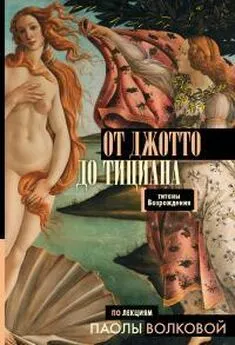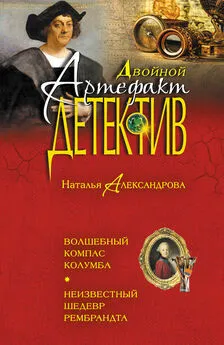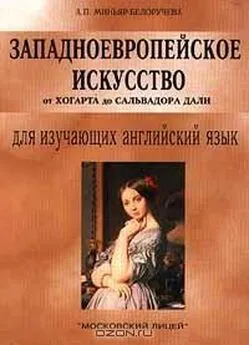А. Миньяр-Белоручева - Западноевропейское искусство от Джотто до Рембрандта
- Название:Западноевропейское искусство от Джотто до Рембрандта
- Автор:
- Жанр:
- Издательство:«Московский Лицей»
- Год:1999
- Город:Москва
- ISBN:5-7611-0181-5
- Рейтинг:
- Избранное:Добавить в избранное
-
Отзывы:
-
Ваша оценка:
А. Миньяр-Белоручева - Западноевропейское искусство от Джотто до Рембрандта краткое содержание
Тексты настоящего пособия охватывают пять веков западноевропейской живописи от Джотто до Рембрандта. Это дает возможность обучаемым приобрести не только лингвистические знания, усвоив обширный лексический материал, но и культурологические, поскольку последовательный хронологический переход текстов от одного художника к другому позволяет создать более или менее целостную картину развития западноевропейской искусства с XIII по XVII вв. Система упражнений направлена на усвоение лексического материала и развитие навыков устной речи.
Данная книга является первой частью цикла учебных пособий для изучающих английский язык и предназначена для студентов-искусствоведов, учащихся классических гимназий, лицеистов и всех интересующихся искусством.
Учебный центр «Московский Лицей»
пособие для изучающих английский язык
издание второе переработанное и дополненное
Москва -1999
Рецензенты:
И. И. Малинина кандидат филологических наук
Н. В. Васютина кандидат филологических наук
РЕКОМЕНДОВАНО кафедрой иностранных языков исторического факультета МГУ им. М. В. Ломоносова
Западноевропейское искусство от Джотто до Рембрандта - читать онлайн бесплатно полную версию (весь текст целиком)
Интервал:
Закладка:
Западноевропейское искусство от Джотто до Рембрандта
Тексты настоящего пособия охватывают пять веков западноевропейской живописи от Джотто до Рембрандта. Это дает возможность обучаемым приобрести не только лингвистические знания, усвоив обширный лексический материал, но и культурологические, поскольку последовательный хронологический переход текстов от одного художника к другому позволяет создать более или менее целостную картину развития западноевропейской искусства с XIII по XVII вв. Система упражнений направлена на усвоение лексического материала и развитие навыков устной речи.
Данная книга является первой частью цикла учебных пособий для изучающих английский язык и предназначена для студентов-искусствоведов, учащихся классических гимназий, лицеистов и всех интересующихся искусством.
Введение
Настоящее пособие состоит из 16 уроков, включающих тексты и упражнения. Материалом данного пособия послужили оригинальные тексты англоязычных искусствоведов. Тематика текстов охватывает пять веков западноевропейской живописи от Джотто до Рембрандта. Это позволяет обучаемым нс только усвоить чрезвычайно обширный лексический пласт «языка искусствоведов», но и создать общее представление об истории западноевропейского искусства.
Объем пособия не позволяет остановиться на всех художниках, которые внесли вклад в мировую сокровищницу живописи. В пособии представлены тексты, посвященные крупнейшим европейским мастерам, работы которых оказали большое влияние на развитие всемирного искусства. Пособие составлено таким образом, что дает возможность обучаемым проследить ход развития западноевропейской живописи с конца XIII века до середины XVII века. Каждый урок состоит из текста, в котором кратко излагаются основные этапы жизни и творчества художника, анализируются его наиболее значительные произведения, а также упражнений, позволяющих проверить как общее понимание прочитанного, так и закрепить только что приобретенный лексический материал. Для облегчения работы с пособием прилагается словарь.
Предлагаемые в данном пособии тексты являются оригинальными, с незначительными сокращениями. Пособие может быть использовано не только студентами-искусствоведами, но и самым широким кругом читателей, интересующихся историей западноевропейской живописи.
Unit I Giotto (c.1267-1337)
The final break with the Byzantine tradition was accomplished by Giotto di Bondone. He was the first giant in the long history of Italian painting; he was a painter, a sculptor and an architect. Now Giotto is regarded as the father of modern painting, but even in his own day Giotto's greatness was recognized by his contemporaries. They listed him as one of the great men of the Florentine Republic, called him the pupil of Nature and said that Giotto revived the art of painting which had declined in Italy because of many invasions.
Giotto's masterpiece is the cycle of frescoes, dating from 1305-1306, illustrating the life of the Virgin and the life of Christ, that lines the interior of the Arena Chapel in Padua. The Redemption of man is the subject, and Jesus and Mary are the protagonists. The two side walls are covered with frescoes on panels arranged in three layers. Giotto painted the Vices on the north wall, and the Virtues on the south wall.
In one of the early scenes, Joachim among the Shepherds, Joachim, father of the Virgin, takes refuge with shepherds in the wilderness after his expulsion from the Temple. Humiliated, his head bowed, he stands before two shepherds, one of whom scans his companion's face to see whether they dare to receive the outcast. The dog, the symbol of fidelity leaps in joyful greeting. Giotto accepted one scale for the figures and another for the surroundings including the animals and the sheepfold. For all his ability to project three-dimensional forms, Giotto is far from having the notion of visual unity. His landscape has an expressive purpose. The cubic rocks form a definite stage in space limited by the blue background. It does not represent the sky; it is an ideal heavenly colour that continues behind all the scenes. In order to emphasize the three-dimensionality of Joachims's figure, Giotto has designed his halo foreshortened in perspective.
Giotto's Madonna and Child Enthroned, of about 1310, is a ceremonial representation of the Virgin as Queen of Heaven. The distant space is ruled out by the traditional background. Giotto introduced light and inward extension in a direct and convincing manner. He placed the throne above a marble step and the Virgin sits firmly within it. The angels kneeling in the foreground are solid. The angels and saints firmly stand on either side of the throne. Light without indication of source, models the forms so heavily that they resemble sculptural masses. Giotto's miracle lay in his ability to produce for the first time on a flat surface three-dimensional forms. Giotto's facial types and drapery motives recall Gothic sculptures.
In the Raising of Lazarus the composition divides into two groups: one centred around Lazarus, who has just risen from the tomb and is still wrapped in graveclothes is read together with the rock; the other beginning with prostrate Mary and Martha, culminates in Christ, who calls the dead man forth by a single gesture of his right hand against the blue. The calm authority is contrasted with the astonishment of the surrounding figures.
In the Lamentation Giotto has enriched the dialogue between life and death. Instead of burst of grief he has staged a tragedy. The figures grieve in the manner possible to their individual personalities. Giotto added to the scene mourners who turn their backs to the spectators; one upholds Christ's head, the other – his right hand. Mary with one arm around Christ's shoulder searches his countenance. Only the angels can cry in pure grief, each half-hidden in clouds to show that they are supernatural. In this scene Giotto's brushwork is as calm as in the other. He achieved this effect not only by the arrangement of figures but also by the diagonal line of the rock, descending toward the faces of Mary and Christ. At the upper right, as if to typify the desolation of the scene a bare tree stands against the blue. Giotto expected his observers to remember that in accordance with the medieval legend, the Tree of Knowledge was withered after the sin of Adam and Eve and made fruitful again after the sacrifice of Christ.
Make sure you know how to pronounce thefallowing words:
Giotto; Jesus Christ; Mary; Madonna; Virgin; Martha; fresco ['freskou]; Adam; Eve; Arena Chapel;
Byzantine; Padua; Florentine; Lazarus; Redemption; recognise; layer; contemporaries; shepherd;
masterpiece; perspective; accomplish; medieval; wilderness; sacrifice; expulsion; angels; surface.
Joachim among the Shepherds – «Встреча Иоакима с пастухами»
Raising of Lazarus – «Воскрешение Лазаря»
Lamentation – «Оплакивание»
Madonna and Child Enthroned – «Величание» («Маеста» из Оньиссанти)
Redemption – Искупление Грехов
The Vices and the Virtues – Грехи и Добродетели
protagonist – главный герой
Joachim – Иоаким
I. Read the text. Mark the following statements true or false.
1. Giotto's greatness is recognized only today.
2. Giotto produced cubic forms on a flat surface.
3. Jesus and Mary are the protagonists of Giotto's frescoes.
4. In Giotto's frescoes the figures float through the heavens.
5. The composition is centred around Lazarus.
6. In the Lamentation to typify the desolation of the scene Giotto depicted a bare tree against the blue background.
II. How well have you read? Can you answer the following questions?
1. How was Giotto characterized by his contemporaries?
2. What did Giotto represent in the frescoes that line the interior of the Arena Chapel in Padua? What is the subject of these frecoes?
3. What did Giotto introduce in his works of art?
4. What is depicted in one of Giotto's earliest frescoes? What device did Giotto use to emphasize the three-dimensionality of Joackim's figure? What scale did he recognize for the figures and for the surroundings?
5. How did Giotto represent the figures in the Madonna and Child Enthroned ? How did Giotto depict the throne? How is the background painted? What models the form in the Madonna and Child Enthroned? What do Giotto's figures resemble?
6. What is represented in the Raising of Lazarus? What groups are distinguished in the fresco? How are they arranged? How did Giotto show the perspective in this fresco?
7. What does the Lamentation depict? How did Giotto group the grieving figures? What medieval legend is connected with the Tree of Knowledge?
III. I Give Russian equivalents of the following phrases:
to be recognized by the contemporaries; protagonist; ceremonial representation; to revive the art of painting; a cycle of frescoes; to line the interior; in the wilderness; to arrange frescoes in three layers; to cover walls with frescoes; to fresco the walls; to form a definite stage in space; frescoes on panels; cubic rocks; three-dimensional forms; a limited space; wrapped in graveclothes; according to the medieval legend; against the blue background; an ideal heavenly colour; Queen of Heaven; to take shelter; firmly stand; to recognize one scale for the figures and another for the surroundings; master's masterpiece; the miracle lies in; light without indication of source; to produce for the first time; to design a halo; to introduce light and inward extension; to group the figures; to resemble sculptural masses; foreshortened in perspective; visual unity; to rule out the distant space; to add mourners; in the foreground; in the background; facial types; to receive an outcast; brushwork; Redemption; Tree of Knowledge; a withered tree; the sin of Adam and Eve; shepherds and sheepfold; on a flat surface.
Читать дальшеИнтервал:
Закладка:
